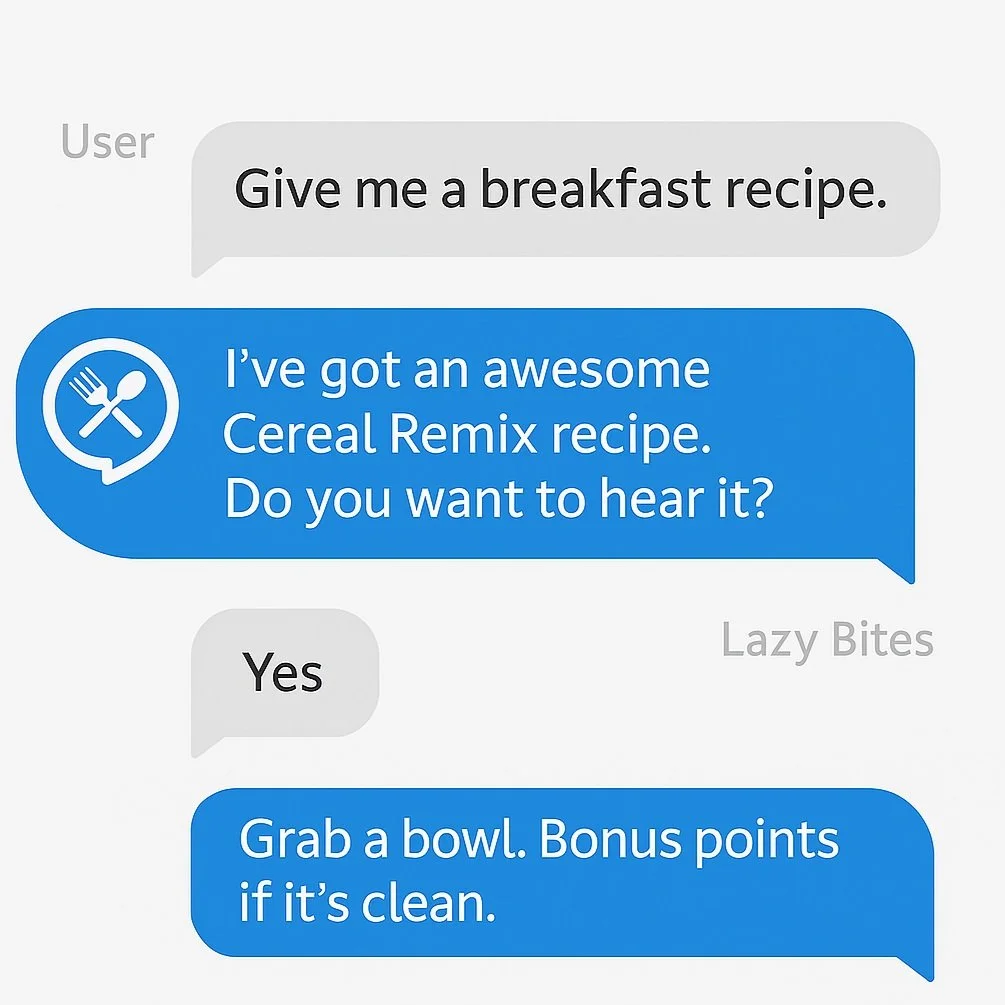
This wasn’t a recipe project. It was a mission to build a softer, more compassionate voice for people whose brains freeze at the dreaded question:
What’s for dinner?
A voice-first recipe skill for decision fatigue.
Lazy Bites is a voice-only Alexa skill designed to make mealtime easier for people experiencing decision fatigue, executive dysfunction, or low emotional bandwidth.
It offers quick 5-minute recipes, emotionally supportive language, and step-by-step voice guidance—so users can feed themselves without the burden of endless decisions or screens.
User Personas
Lazy Bites was shaped by real stories of neurodivergence, burnout, and overwhelm.
-

Samira
THE BURNED-OUT STUDENT
“When my brain is fried from studying, even deciding on toast feels like rocket science.”
Needs: Simple, no-pressure cooking guidance when she’s exhausted
Frustrations: Overwhelmed by long recipes and guilt about takeout
-

Jan
THE NEURODIVERGENT FREELANCER
“I just want someone to tell me one small step at a time—without a million photos or pop-ups.”
Needs: Clear, step-by-step voice instructions without sensory overload
Frustrations: Visual recipe apps feel cluttered and stressful
-

Priya
THE SLEEP-DEPRIVED MOM
“I’m running on 3 hours of sleep—just tell me how to make something edible without judging me.”
Needs: Fast, brainless meal ideas while caring for a newborn
Frustrations: Too tired to think, hates being shamed for shortcuts
Traditional recipe apps are designed for people with time, energy, and executive function to spare.
-
For neurodivergent users or anyone running on low spoons, these apps can feel overwhelming:
Endless filters and categories
Cluttered visuals
Long ingredient lists
A constant undertone of guilt and judgment
When your brain is fried, even the question What’s for dinner? can trigger decision paralysis.
Lazy Bites set out to change that.
-
Design a voice-first skill that feels more like a gentle companion than a recipe book.
One that:
Reduces cognitive load through clear, step-by-step guidance
Uses affirming, emotionally supportive language
Works hands-free—no screens, no scrolling, no overwhelm
Turns cooking from a source of shame into a moment of self-compassion
-
I combined Wizard of Oz testing, interviews, and observation to understand how users behave when they’re exhausted or overstimulated.
Activities included:
6 Wizard of Oz sessions simulating the skill in real time
Remote interviews with neurodivergent adults and new parents
Voice flow mapping to identify friction points
Language testing to gauge tone and clarity
Voice Flow & Interaction Model
Lazy Bites uses a finite state machine to guide users through three emotionally safe stages
-
Lazy Bites: “What are you in the mood for : breakfast, lunch, dinner, or a snack?”
Validates input with clear slot matching
Gently corrects if input is unclear
-
Lazy Bites: “I found a super simple hummus wrap recipe. Wanna hear it?”
Randomly selects recipes from a dynamic array
Lets users hear ingredients before deciding
-
Lazy Bites: “Crack 2 eggs into a mug. Say ‘next’ to continue.”
Provides a single instruction at a time
Allows users to say ‘next’, ‘repeat’, or ‘different recipe’
Ends with positive reinforcement: “Excellent—enjoy your creation!”
-
I designed error handling to feel clear and non-judgmental. Each mode has dedicated fallback prompts that gently guide users back on track without creating frustration.
For example, if someone says something unexpected during step-by-step instructions, Lazy Bites responds with: “Sorry, I didn’t understand you there. You can say ‘next’ to keep going or ‘repeat’ to hear the step again.”
This approach ensured users never felt stuck or embarrassed, and helped reduce cognitive load for neurodivergent testers.
Iterations & Refinements
Through Wizard of Oz testing and feedback loops, I made multiple adjustments to improve clarity and reduce stress.
-
Observation
During Wizard of Oz testing, users kept forgetting they could say ‘repeat’ to hear the instruction again.
Before
Lazy Bites: “Crack 2 eggs into a mug.”
If the user was distracted or missed it, they often hesitated or said things like “Wait—what?”
Improvement
I added a soft reminder after each step, so users always knew their options without feeling stuck.
After
Lazy Bites: “Crack 2 eggs into a mug. When you’re ready, say ‘next’ to continue or ‘repeat’ to hear this step again.”
This change lowered cognitive load and supported a calmer experience, leading to smoother task completion without extra friction.
-
Observation
During testing, I realised that the ‘surprise me’ feature confused most users. When I prompted them with:
Lazy Bites: “Say ‘surprise me’ to hear something random!”
they often asked:
“Surprise me with what?”
“Can I change it if I don’t like it?”
This uncertainty made them hesitate or abandon the flow.
Improvement
To reduce friction, I removed the surprise me option altogether. Instead, I switched to clear, direct suggestions:
Lazy Bites: “I found a super simple hummus wrap recipe. Want me to tell you how to make it?”
This way, users always knew exactly what to expect, and the interaction felt predictable and safe.
-
Observation
A few users were confused by a joke in the Lazy Omelette instructions.
Lazy Bites: “Whisk with whatever you can find — fork, chopstick, electric toothbrush… kidding.”
When someone is already burnt out, even a playful line can create unnecessary doubt.
Improvement
I simplified the humour to keep the tone warm but clear and planned a serious mode toggle for the future.
After
Lazy Bites: “Whisk with whatever you have — a fork or a chopstick both work.”
In serious mode, the same line will be even more straightforward:
Lazy Bites: “Whisk with a fork until smooth.”
This change reduced ambiguity and kept the instructions predictable, especially for neurodivergent users who appreciate literal, no-nonsense guidance.
-
Observation
A few testers asked for vegetarian or other dietary filters, but these weren’t in scope for the MVP.
Before
User: “Do you have vegetarian options?”
Lazy Bites: “I’m not sure.”
After
I added a gentle acknowledgment to manage expectations and validate the request:
Lazy Bites: “I’m not there yet, but it’s on my mind. For now, I can suggest another recipe or list the ingredients to help you decide.”
Accessibility and inclusion were at the heart of Lazy Bites from day one. I shaped every interaction to meet the needs of neurodivergent and burned-out users with clarity and compassion.
Tone & Content Strategy
Tone & Content Strategy
From the start, I shaped Lazy Bites’ voice to feel like a kind friend:
warm and affirming to reassure users they were doing enough,
short and clear to ease decision fatigue,
lightly humorous to soften the stress of cooking when you’re exhausted.
What Went Well
Key Challenges & Learnings
If I Had More Time
-
I would build a serious mode toggle so users could switch to a fully neutral tone on hard days.
-
I’d implement dietary filters for vegetarian, vegan and allergy friendly options.
-
I’d expand the recipe database to keep the experience feeling fresh over time.
Summary & Reflections
Lazy Bites is more than a recipe skill.
It’s proof that when you design for burnout and neurodivergence, you’re really designing for human dignity—meeting people with patience, humour, and care exactly where they are.
Curious about the details?


